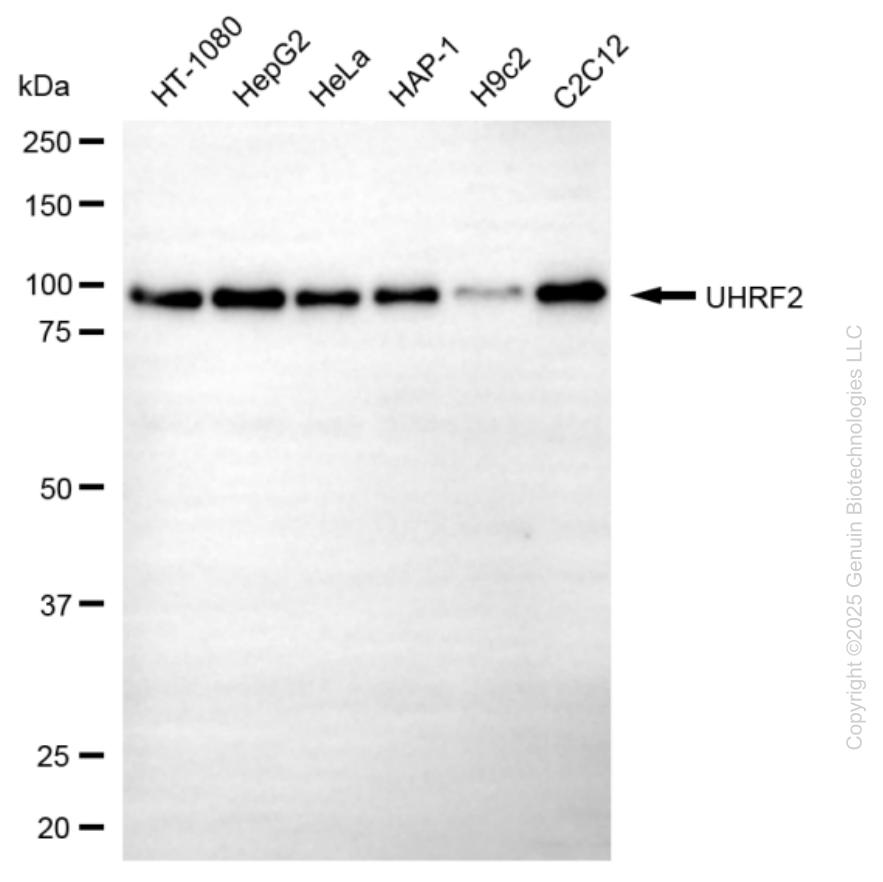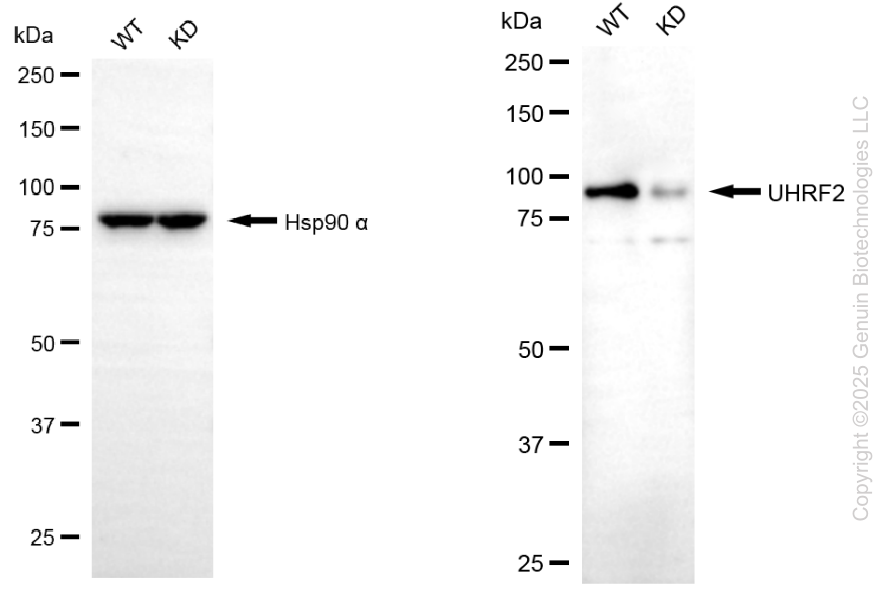KD-Validated Anti-UHRF2 Mouse Monoclonal Antibody
Mouse monoclonal antibody
- SPECIFICATION
- CITATIONS
- PROTOCOLS
- BACKGROUND

Application
| WB |
|---|---|
| Primary Accession | Q96PU4 |
| Reactivity | Rat, Human, Mouse |
| Clonality | Monoclonal |
| Isotype | Mouse IgG1 |
| Clone Names | 24GB14330 |
| Calculated MW | Predicted, 90kDa, observed, 95 kDa |
| Gene Name | UHRF2 |
| Aliases | UHRF2; Ubiquitin Like With PHD And Ring Finger Domains 2; RNF107; NIRF; TDRD23; URF2; Ubiquitin-Like With PHD And Ring Finger Domains 2, E3 Ubiquitin Protein Ligase; Ubiquitin-Like-Containing PHD And RING Finger Domains Protein 2; Ubiquitin-Like PHD And RING Finger Domain-Containing Protein 2; RING-Type E3 Ubiquitin Transferase UHRF2; Np95/ICBP90-Like RING Finger Protein; E3 Ubiquitin-Protein Ligase UHRF2; Np95-Like Ring Finger Protein; RING Finger Protein 107; Nuclear Protein 97; MGC33463; Ubiquitin-Like, Containing PHD And RING Finger Domains, 2; Nuclear Zinc Finger Protein NP97; Nuclear Zinc Finger Protein Np97; Np95-Like RING Finger Protein; EC 2.3.2.27; EC 6.3.2 |
| Immunogen | Recombinant protein of human UHRF2 |
| Gene ID | 115426 |
|---|---|
| Other Names | E3 ubiquitin-protein ligase UHRF2, 2.3.2.27, Np95/ICBP90-like RING finger protein, Np95-like RING finger protein, Nuclear protein 97, Nuclear zinc finger protein Np97, RING finger protein 107, RING-type E3 ubiquitin transferase UHRF2, Ubiquitin-like PHD and RING finger domain-containing protein 2, Ubiquitin-like-containing PHD and RING finger domains protein 2, UHRF2, NIRF, RNF107 |
| Name | UHRF2 |
|---|---|
| Synonyms | NIRF, RNF107 |
| Function | E3 ubiquitin ligase that plays important roles in DNA methylation, histone modifications, cell cycle and DNA repair (PubMed:15178429, PubMed:23404503, PubMed:27743347, PubMed:29506131). Acts as a specific reader for 5-hydroxymethylcytosine (5hmC) and thereby recruits various substrates to these sites to ubiquitinate them (PubMed:24813944, PubMed:27129234). This activity also allows the maintenance of 5mC levels at specific genomic loci and regulates neuron-related gene expression (By similarity). Participates in cell cycle regulation by ubiquitinating cyclins CCND1 and CCNE1 and thereby inducing G1 arrest (PubMed:15178429, PubMed:15361834, PubMed:21952639). Also ubiquitinates PCNP leading to its degradation by the proteasome (PubMed:12176013, PubMed:14741369). Plays an active role in DNA damage repair by ubiquitinating p21/CDKN1A leading to its proteasomal degradation (PubMed:29923055). Also promotes DNA repair by acting as an interstrand cross-links (ICLs) sensor. Mechanistically, cooperates with UHRF1 to ensure recruitment of FANCD2 to ICLs, leading to FANCD2 monoubiquitination and subsequent activation (PubMed:30335751). Contributes to UV-induced DNA damage response by physically interacting with ATR in response to irradiation, thereby promoting ATR activation (PubMed:33848395). |
| Cellular Location | Nucleus {ECO:0000255|PROSITE-ProRule:PRU00358, ECO:0000269|PubMed:12176013, ECO:0000269|PubMed:23404503, ECO:0000269|PubMed:27129234, ECO:0000269|PubMed:27743347, ECO:0000269|PubMed:29923055, ECO:0000269|PubMed:30335751}. Chromosome. Note=Enriched at genomic loci that are enriched for 5-hydroxymethylcytosine (5hmC) |

Thousands of laboratories across the world have published research that depended on the performance of antibodies from Abcepta to advance their research. Check out links to articles that cite our products in major peer-reviewed journals, organized by research category.
info@abcepta.com, and receive a free "I Love Antibodies" mug.
Provided below are standard protocols that you may find useful for product applications.
If you have used an Abcepta product and would like to share how it has performed, please click on the "Submit Review" button and provide the requested information. Our staff will examine and post your review and contact you if needed.
If you have any additional inquiries please email technical services at tech@abcepta.com.













 Foundational characteristics of cancer include proliferation, angiogenesis, migration, evasion of apoptosis, and cellular immortality. Find key markers for these cellular processes and antibodies to detect them.
Foundational characteristics of cancer include proliferation, angiogenesis, migration, evasion of apoptosis, and cellular immortality. Find key markers for these cellular processes and antibodies to detect them. The SUMOplot™ Analysis Program predicts and scores sumoylation sites in your protein. SUMOylation is a post-translational modification involved in various cellular processes, such as nuclear-cytosolic transport, transcriptional regulation, apoptosis, protein stability, response to stress, and progression through the cell cycle.
The SUMOplot™ Analysis Program predicts and scores sumoylation sites in your protein. SUMOylation is a post-translational modification involved in various cellular processes, such as nuclear-cytosolic transport, transcriptional regulation, apoptosis, protein stability, response to stress, and progression through the cell cycle. The Autophagy Receptor Motif Plotter predicts and scores autophagy receptor binding sites in your protein. Identifying proteins connected to this pathway is critical to understanding the role of autophagy in physiological as well as pathological processes such as development, differentiation, neurodegenerative diseases, stress, infection, and cancer.
The Autophagy Receptor Motif Plotter predicts and scores autophagy receptor binding sites in your protein. Identifying proteins connected to this pathway is critical to understanding the role of autophagy in physiological as well as pathological processes such as development, differentiation, neurodegenerative diseases, stress, infection, and cancer.



